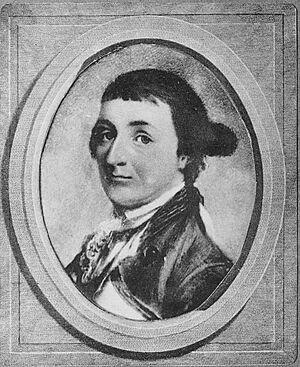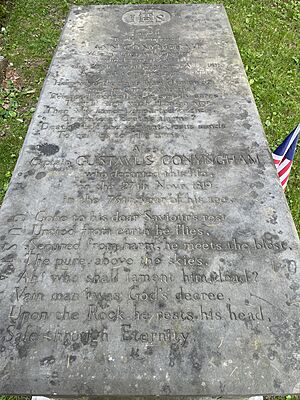Gustavus Conyngham facts for kids
Gustavus Conyngham (born around 1747 – died 1819) was an amazing Irish-born American sea captain. He was an officer in the Continental Navy and also a privateer, which was like a government-approved pirate! During the American Revolutionary War, he fought against the British. Between May 1777 and May 1778, he captured 24 British ships in the eastern Atlantic Ocean. This made shipping very expensive for the British. Many people called him "the most successful of all Continental Navy captains."
Contents
Early Life and Sea Adventures
Gustavus Conyngham was born in County Donegal, Ireland, in 1747. He moved to British America in 1763, hoping for a better life. He settled in Philadelphia to work for his cousin, Redmond Conyngham, in the shipping industry. Gustavus left school young because he felt his future was on the ocean, not in books. He became an apprentice to Captain Henderson, who taught him everything about sailing. Eventually, Gustavus became captain of his own ship, the Charming Peggy. When the Revolutionary War started in 1775, he sailed to Europe to get supplies for the American war effort.
Great Britain was watching for anyone trying to buy weapons. Gustavus had planned to get supplies from Dutch traders. But his ship got stuck in calm winds for too long. The British found him because a sailor on his ship told them where he was.
A British officer, Andrew Frazer, put guards on the Charming Peggy. He ordered the ship to sail to England when the wind picked up. However, when the weather changed, Gustavus and his crew bravely overpowered the guards and escaped! But the wind soon died again, leaving them stuck. Instead of waiting to be caught, Gustavus sold the Charming Peggy to the Dutch government. He hoped to buy a new ship without being suspected. Sadly, due to problems with money management in the government, he never got paid for his ship. He had to find another way to complete his mission.
Meeting Benjamin Franklin
After losing his ship, Gustavus went to France, hoping to find help for the United States. There, he met Benjamin Franklin, a very important American who would help him many times. They became good friends, and Gustavus even called Franklin "the Philosopher" because he was so smart and clever.
Franklin had special papers called commissions from the Continental Navy. These papers allowed people to become official captains. On March 1, 1777, Gustavus was made captain of a small ship called the Surprise. He quickly got to work, sailing into the narrow English Channel. Within a week, he captured two British ships: the Prince of Orange and the Joseph. The Prince of Orange mostly carried mail, so he sent it to Dunkirk. The Joseph had valuable cargo like wine and oranges, so he sent it to France as a prize.
Unfortunately, France had an agreement with England that didn't allow selling captured goods in French ports. When Lord Stormont, a British official, heard about Gustavus's actions, he demanded that France return the Joseph and arrest Gustavus. France didn't want to start a war with England, so they agreed. They returned the Joseph and arrested Gustavus. He was sent to a French prison, accused of acting like a pirate.
Success Aboard the Revenge
Once again, Benjamin Franklin came to Gustavus's rescue. Franklin knew Gustavus was a very skilled sailor because he had avoided the British in their own waters. Franklin decided to get him a new ship. This was difficult because England was watching for new ships being built to help America. So, the ship was secretly built as the Greyhound. Franklin used fake buyers to trick the English. One of these buyers, Richard Hodge, sailed the ship out to sea. There, Gustavus boarded it and took command, renaming it the Revenge.
The Revenge was bigger, faster, and had more cannons than the Surprise. Gustavus immediately started causing big problems for British shipping. This is when he earned his nickname "the Dunkirk Pirate." He ignored his orders to go straight to America and instead sailed to Dunkirk to continue his attacks on the British.
The Dunkirk Pirate's Raids
On his first trip, he captured or sank a ship almost every three days! He took down over twenty ships in the Baltic and North Sea in just two months. Then he sailed to Cap Ferrol to get more supplies and crew members. He then went to the West Indies, using Spain as his main base. Over the next eighteen months, he captured or sank sixty more ships. This caused the cost of shipping insurance between Dover and Calais to go up by 10%. This was the highest it had ever been, even more than during England's wars with France and Spain! Many merchants started paying French and Dutch ships to carry their goods because they were so afraid of the Dunkirk Pirate.
It was even reported that the King of England himself said he would love to see Gustavus Conyngham caught and punished. Not even bad weather could stop him. When a storm badly damaged his ship in English waters, he cleverly disguised the Revenge and sailed into an English port for repairs. He spoke in his native Irish language to avoid being recognized. Once, when offered a large Spanish warship for protection against two small British ships planning to ambush him, he bravely said he "was not afraid of fifty of their boats." He even wished they would try to attack him!
Gustavus's successful attacks off the English coast ended when he captured a ship carrying valuable war supplies. He decided these supplies were important enough to take directly to America. He arrived in Philadelphia on February 21, 1779, with his captured goods. This is when his good luck started to change.
Challenges and Imprisonment
It's strange that the first friendly port Gustavus had seen in years treated him poorly. Local newspapers called him a war hero, but the Continental Congress was not happy. They were upset he didn't follow orders and that he had lost his original commission papers when he was in the French prison. Also, since Gustavus didn't own the Revenge, it was sold at a private auction.
Still, because he had been such a successful captain, he was given command again. His new orders were to raid British shipping for profit. However, during one of his first trips, he couldn't escape the British warship HMS Galatea. He was captured and taken prisoner. Because he was so famous, his guards treated him very badly. He reported that he was kept in chains until he reached prison. He had only a "cold plank as my bed, a stone for a pillow." He also wasn't fed properly and lost fifty pounds while on the ship to his English prison.
Since he didn't have his official commission papers at the time, he was arrested on serious charges and sent to Pendennis Castle prison. He escaped from there, but was caught again and sent to Mill Prison in Plymouth. He was kept in chains constantly at both prisons.
It was only thanks to Benjamin Franklin that Gustavus avoided a very serious punishment. Franklin wrote to General George Washington about Gustavus's missing commission. Washington then wrote to the British, saying that if Gustavus was harmed, he would harm six British officers he had captured.
Despite these harsh conditions, Gustavus refused to join the British Navy to get out of prison. In fact, while in prison, he helped create a document that prisoners signed, promising not to give up on the American cause, no matter how bad things got. Gustavus was put on trial for serious charges against his country, but he escaped before his sentence was decided. Gustavus and eleven other prisoners broke into the prison vault. They used tools to dig a tunnel "a considerable distance" under the prison wall. If a boy hadn't broken his arm while trying to get out, alerting the guards, hundreds more prisoners might have escaped with him.
Escape and Return to America
After his escape, Gustavus fled to Texel Island in the Netherlands. He wanted to find a way back to America to get a new ship. He was in good spirits – he later said he was amused by the pictures of himself as a monster that he saw all over London while in disguise. He planned to go back to France to get help from Benjamin Franklin again. But instead, he got lucky. While resting in Texel, John Paul Jones arrived in port after his famous battle with the Serapis. Jones took Gustavus aboard, and they sailed together for several months. Gustavus then left Jones's ship at a Spanish port to board a ship heading for America.
However, his luck ran out again. While on the ship Experiment heading to America, he was recaptured by the British on March 17, 1780. He was sent back to Mill Prison in Plymouth. He stayed there until he was released in a political prisoner exchange. This time, he went to Ostend, where he got an armed ship called the Layona. He was preparing to go sailing again, but then he heard news of a peace treaty. Instead, he boarded the Hannibal, which was on its way back to his hometown of Philadelphia.
Later Life and Legacy
In many ways, his second return to the United States was not as welcoming as the first. The Continental Congress refused to pay him properly for his work. This was because he couldn't show his official commission papers, which the French had taken from him almost three years earlier. Since Benjamin Franklin had given him an official commission, he was not just a privateer, but a real Captain in the United States Navy. This meant he should have received a share of the value of the ships he captured. But because he couldn't produce his commission, and Benjamin Franklin died before he could confirm it, the Continental Congress refused to pay him what he was owed. They treated him like a common privateer for his earliest and most successful raids.
Despite his disagreements with the government, he continued to serve his country. During the Quasi-War with the French, he captained the Maria, an armed merchant ship, bringing much-needed supplies. Towards the end of his life, he was elected to the Common Council of Philadelphia. He also managed to raise thirty thousand dollars in loans from people to help defend the city during the War of 1812. He never let his problems with politicians stop his commitment to his country. He died peacefully at his home on November 27, 1819. He is buried with his wife, Ann Conyngham, in the churchyard of St. Peter's Episcopal Church in Philadelphia.
Almost a hundred years later, John Sanford Barnes, a retired navy captain and historian, found a collection of old papers. In this collection was Gustavus Conyngham's original commission from Benjamin Franklin! Barnes shared his discovery in September 1902, finally proving Gustavus's official status.
Honoring Gustavus Conyngham
Three ships in the United States Navy have been named USS Conyngham in his honor. Also, Conyngham Borough in Luzerne County, Pennsylvania, was named after him.
Images for kids





